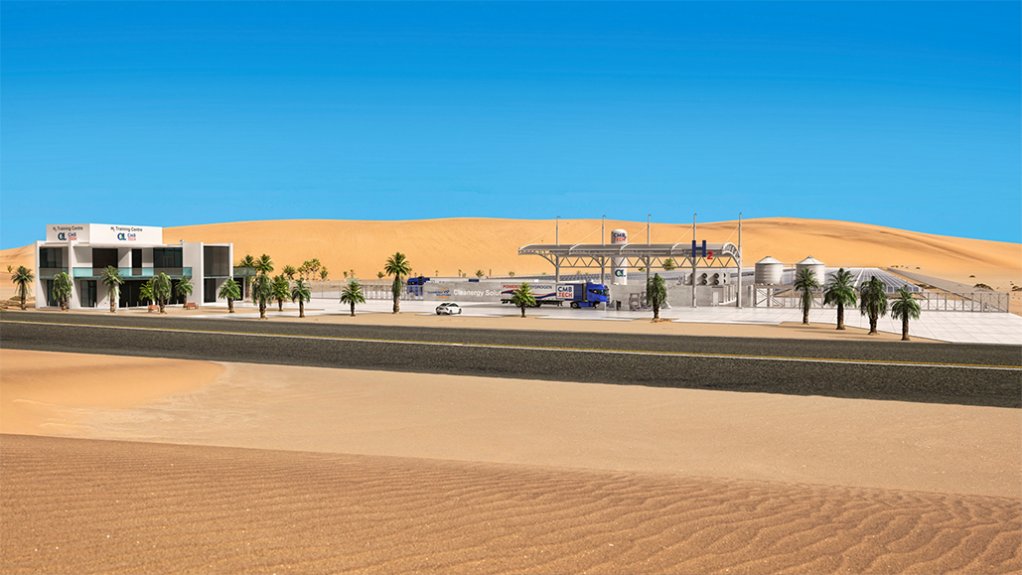
+27 11 441 1111
SRK House, 265 Oxford Road, Illovo, 2196, South Africa

Company paves way with green hydrogen plant



HYDROGEN DEMONSTRATION PLANT An illustration of the proposed Cleanergy green hydrogen demonstration plant, in Walvis Bay
LAETITIA COETSER Responsible waste management, as well as glint and glare management, have become critical considerations for the project
With increasing momentum in clean energy, and initiatives for a sustainable and low-carbon future, project developers are turning their attention to Namibia, a country rich in renewable-energy potential, as an ideal host for green hydrogen initiatives.
Among these projects, engineering consultancy SRK Consulting highlights the Green Hydrogen Demonstration Plant (GHDP) near Walvis Bay, “as it embodies the fusion of renewable resources and sustainable technologies”.
SRK Consulting conducted the environmental-impact assessment (EIA) for the project on its proposed pilot site, owned by renewable natural resources company Cleanergy Solutions Namibia, which is planning to become “one of the first companies in Namibia to produce commercial grade hydrogen from water using renewable-energy sources”.
Cleanergy Solutions Namibia is a joint venture between the Namibian O&L Group and Belgian shipping group CMB.
The EIA enabled construction to start in June this year.
The EIA encapsulated a spectrum of considerations, ranging from ground- and surface water to archaeology, air quality, flora, fauna and noise, says SRK Consulting partner and principal scientist Dr Laetitia Coetser.
Additionally, the assessment diligently factored in the project’s contribution to climate change, including greenhouse-gas emissions during the construction and operation phases.
To ensure the responsible development of the project, SRK Consulting meticulously formulated an environmental management plan (EMP), which outlined strategies to mitigate potential impacts and served as a roadmap for adherence to established environmental standards throughout the project’s life cycle.
The EMP embodies a comprehensive approach, while safeguarding the project’s ecological integrity.
Further, responsible waste management, as well as glint and glare management, have become critical considerations for the project, which is located about 4 km from the Walvis Bay Airport.
Coetser explains that the glare from solar plants located in close proximity to an aerodrome or under flight paths may impair a pilot’s ability to navigate, while improper waste management may attract scavenging animals.
The GHDP has, therefore, been designed to adhere to international best practices for effective waste management and visual impact management on site.
During construction, an area will be designated, cordoned off and secured specifically for construction waste that will be required to be cleaned up by waste removal companies.
Hazardous waste will be separated at source at designated collection points, which will allow for the appropriate segregation and storage of this waste stream pursuant to compatibility requirements.
With regard to the management of the visual impact, Coetser says a detailed management plan has been developed to reduce the impact, not only on the Walvis Bay Airport but also surrounding areas.
As such, she explains that an ocular analysis of glint and glare for the project will be undertaken to model whether glint and glare will be experienced and to present additional management measures if required.
Meanwhile, the GHDP is not only about energy production – it is about nurturing skills that can support green hydrogen projects, and fostering economic growth within Namibia.
“Albeit small, as this is only a demonstration plant, the sale of hydrogen will also contribute to the Namibian economy,” she reiterates, noting that an integral component of the project is a training centre that collaborates closely with local vocational training institutions and academic entities.
This partnership ensures that the workforce is adequately equipped to cater to the needs of the pilot project and commercial facilities.
“This strategy aligns seamlessly with the overarching goal of cultivating a local talent pool to drive green hydrogen initiatives, thereby diversifying the economy and bolstering the nation's gross domestic product,” she tells Engineering News.



